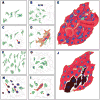Stem cell death and survival in heart regeneration and repair
- PMID: 26687129
- PMCID: PMC5200890
- DOI: 10.1007/s10495-015-1203-4
Stem cell death and survival in heart regeneration and repair
Abstract
Cardiovascular diseases are major causes of mortality and morbidity. Cardiomyocyte apoptosis disrupts cardiac function and leads to cardiac decompensation and terminal heart failure. Delineating the regulatory signaling pathways that orchestrate cell survival in the heart has significant therapeutic implications. Cardiac tissue has limited capacity to regenerate and repair. Stem cell therapy is a successful approach for repairing and regenerating ischemic cardiac tissue; however, transplanted cells display very high death percentage, a problem that affects success of tissue regeneration. Stem cells display multipotency or pluripotency and undergo self-renewal, however these events are negatively influenced by upregulation of cell death machinery that induces the significant decrease in survival and differentiation signals upon cardiovascular injury. While efforts to identify cell types and molecular pathways that promote cardiac tissue regeneration have been productive, studies that focus on blocking the extensive cell death after transplantation are limited. The control of cell death includes multiple networks rather than one crucial pathway, which underlies the challenge of identifying the interaction between various cellular and biochemical components. This review is aimed at exploiting the molecular mechanisms by which stem cells resist death signals to develop into mature and healthy cardiac cells. Specifically, we focus on a number of factors that control death and survival of stem cells upon transplantation and ultimately affect cardiac regeneration. We also discuss potential survival enhancing strategies and how they could be meaningful in the design of targeted therapies that improve cardiac function.
Keywords: Apoptosis; Cell death; Heart; Regeneration; Stem cells; Therapy.
Figures


References
-
- Passier R, van Laake LW, Mummery CL. Stem-cell-based therapy and lessons from the heart. Nature. 2008;453:322–329. - PubMed
-
- Check E. Cardiologists take heart from stem-cell treatment success. Nature. 2004;428:880. - PubMed
-
- Wu X, Ding S, Ding Q, Gray NS, Schultz PG. Small molecules that induce cardiomyogenesis in embryonic stem cells. J Am Chem Soc. 2004;126:1590–1591. - PubMed
Publication types
MeSH terms
Substances
Grants and funding
LinkOut - more resources
Full Text Sources
Other Literature Sources
Medical

